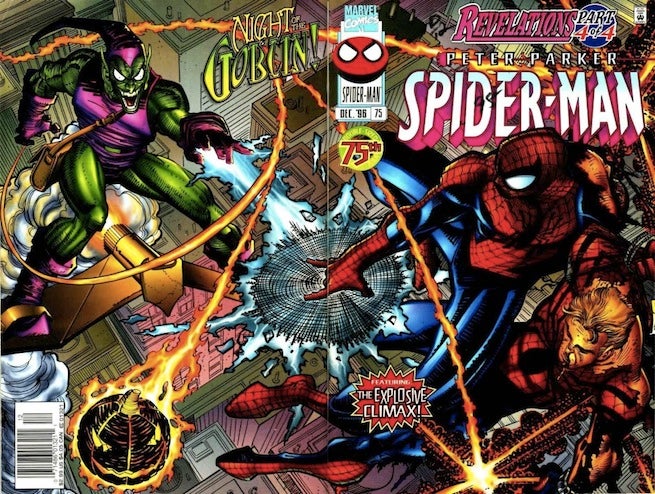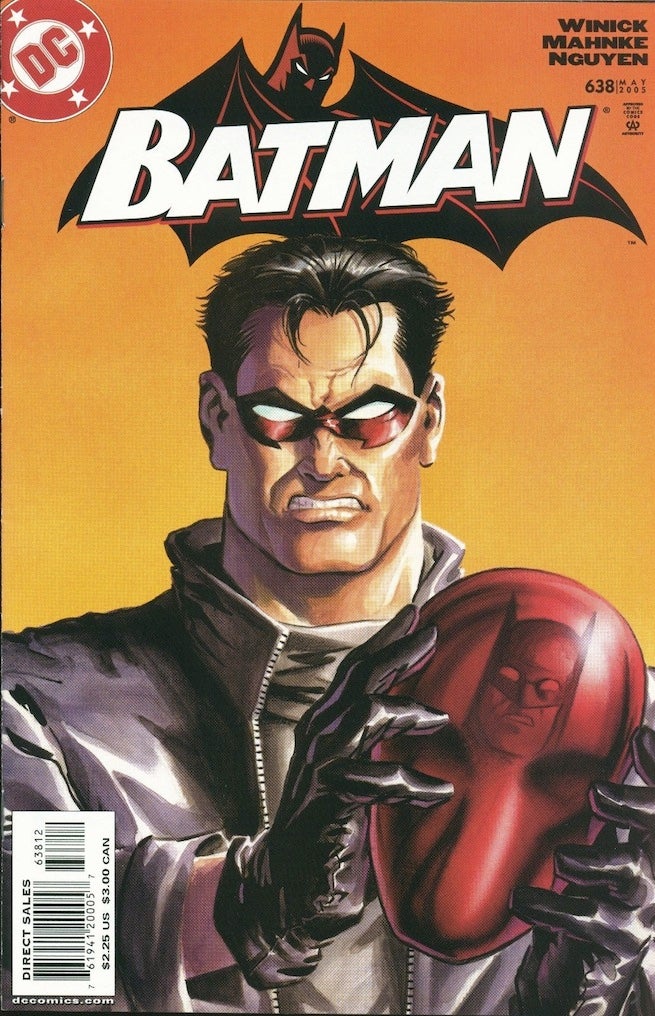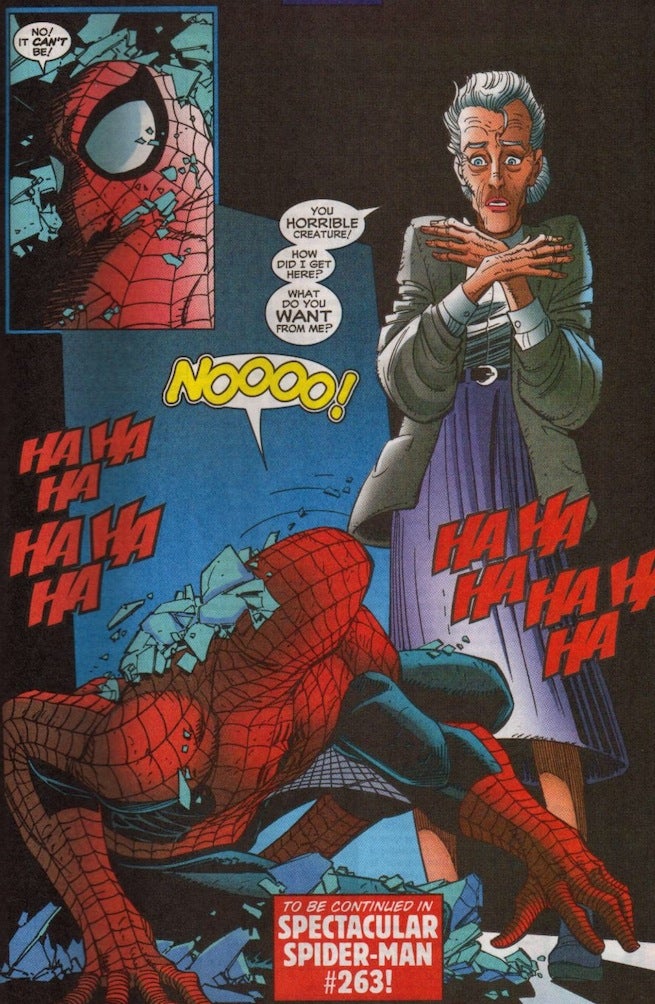10 Unbelievable Comic Book Resurrections
When viewers last saw Arrow’s Oliver Queen in December, it appeared that the character has been [...]

When viewers last saw Arrow's Oliver Queen in December, it appeared that the character has been shockingly killed during a battle with Ra's al Ghul. Arrow actor Stephen Amell even cheekily tweeted out, "it was a good run" after the episode aired, leaving fans to maybe, possibly, believe that they had all just witnessed the death of Arrow's titular character.
Or maybe not. Fans of superhero comics know of the medium's long history of killing off key characters only for them to miraculously return no a year or two later (or sometimes less). So while we await the fate of Oliver, we thought we'd run through 10 resurrections that truly stretched the limits of credulity:

10. Hawkeye
The purple outfit-wearing, arrow firing Avenger Clint Barton met his fateful end during the controversial "Avengers Disassembled" arc after Scarlet Witch ignited his quiver of explosive arrows and the hero sacrificed himself to destroy a Kree warship.
However, a few months later, it appeared that the reports of Hawkeye's death were greatly exaggerated. As part of the alternate reality Scarlet Witch created in House of M, Hawkeye was back among the living, with no memory of what happened to him. Eventually, all of the heroes get wise to the fact that Scarlet Witch was playing make-believe with their lives, including Hawkeye, who promptly attacks her. Scarlet Witch essentially unmakes her reality, disintegrating Hawkeye in the process.
Still, the archer would not be denied. House of M ends with Captain America finding one of Hawkeye's outfits and a newspaper clipping about his death – an indication that Clint was still alive out there.

9. Norman Osborn
Spider-Man's arch nemesis, industrialist Norman Osborn, aka the Green Goblin, died in one of the most iconic storylines in comic book history – "The Night Gwen Stacy Died." After killing the love of Peter Parker's life, Gwen, Spidey and the Goblin have a vicious fight inside of one of Osborn's abandoned warehouses. Spider-Man has the Goblin defeated, but refuses to kill his adversary so as not to lower himsself to his level. Instead, Norman does the dirty work for him, when he summons his Goblin Glider in order to sneak attack Peter and instead impales himself. And thus ended the Norman Osborn era in Spider-Man.
Except more than 20 years later, Marvel decided it was time to bring Norman back. And not only was Norman returning, but he was returning to be revealed as the mastermind behind one of the most controversial eras in Spider-Man history – the "Clone Saga." The explanation of Norman's disappearance – something about having his body replaced for his funeral and living in Europe, recuperating and plotting against his enemies – was immaterial. The Green Goblin was back baby!
Actually, despite the fact that his return sorta, kinda sullies one of the all-time great Bronze Age stories, Spidey's rogue's gallery was getting pretty thin by the end of the "Clone Saga." There's only so many Jackal and Carnage stories one can do. Norman's return at least reinvigorated Spider-Man after one of its darkest periods, while giving him someone to fight who actually mattered.

8. Bucky Barnes
The death of Captain America's World War II sidekick, Bucky Barnes was considered one of the truly sacred, untouchable things in the world of comics. In fact, people would often say, no one is dead in comics except for Uncle Ben, Jason Todd (wait for that one) and Bucky.
Well, Ed Brubaker and Steve Epting disagreed during their epic run on Captain America in the mid-2000s. The creative team resurrected Bucky in one of the most unexpected ways possible. Rather than perishing in that fateful plane explosion (as everyone thought), Bucky crashed into the water below and his body was rescued by a group of KGB scientists/soldiers. They rebuilt Bucky's arm and brainwashed him, transforming the former sidekick into a killing machine. Cap eventually discovers the truth about his old friend and confronts him, convincing him that he's not the villain he thinks himself to be.
Obviously, Bucky is a case where a shocking resurrection paid off huge dividends for Marvel and its fans. "The Winter Soldier" is considered one of the truly great modern era stories (and was adapted for last year's Captain America: The Winter Soldier), while Bucky has been an integral part of the Marvel Universe, even replacing Captain America for a few years while Cap was believed to be dead (not on this list, but an interesting resurrection story there).

7. Jean Grey
In the final chapter of one of the greatest superhero stories of all time, Jean Grey, one of the original X-Men, committed suicide, thereby bringing to a close the "Dark Phoenix Saga." As rumor had it, Marvel's editor-in-chief, Jim Shooter, demanded that Jean face legit consequences after she murdered billions of people while consumed by the dark Phoenix Force. Jean's suicide was a true game-changing moment for Marvel, as a hero as prominent as Jean had never been killed off so definitively.
By the late 1980s, Marvel was ready to launch a brand new X-Men spinoff book, X-Factor, starring the original cast of X-Men #1. With Jean dead, Marvel needed to think of a way to resurrect her for this new series. So rather than being killed during the "Dark Phoenix Saga," Jean was actually stuck inside a cocoon at the bottom of Jamaica Bay (as she was before she inherited the Phoenix Force). And to explain away all those people she killed during "Dark Phoenix Saga," it was written in that Jean didn't actually commit those acts of genocide but it was just the Phoenix Force in tangible form. So not only was Jean resurrected, but she was absolved of her sins too.

6. Superman
The world seemingly came to a crashing halt (hyperbole alert) when DC decided to kill off its greatest icon, Superman, in the early 90s. Killing off a hero on the level of Superman – a character that has transcended the comic book genre and became a wholesale institution of American pop culture – was just plainly unheard of when the "Death of Superman" came out. The comic was released in a black memorial polybag with a whole host of goodies inside. It sold millions of copies as speculators thought they were hoarding a piece of history. History had been made.
But if the "Death of Superman" proved anything it's that it takes a lot more than an alien menace like Doomsday to keep a hero like Superman down (not to mention resurrecting the "Man of Steel" was bound to be a boon for sales). Within a year, Superman was back wearing his iconic "S" again. But first came the "Superman: Reign" storyline, which saw four different characters approach Metropolis all claiming to be the real Supes. Of course none of them were, but that didn't hurt what many consider to be one of the better Superman stories from the past 25 years.

5. The Thing
In the midst of the beloved Mark Waid/Mike Wieringo run on Fantastic Four in the early 2000s (Fantastic Four #511), the loveable rockman from Yancy Street is killed by his buddy Reed Richards after he is possessed by Doctor Doom. Reed, being the man of science that he is, instantly goes looking for a cure, and discovers that there's maybe a chance of bringing Ben back if they can retrieve his soul from heaven.
That plot point alone should have raised a few eyebrows but Waid and Ringo go one step further when the team enters heaven and finds itself face-to-face with none other than God himself – who is actually an artist who bears a striking physical resemblance with Fantastic Four co-creator Jack Kirby. KirbyGod proceeds to bring Ben back to life by drawing him into existence, thus reuniting the Fantastic Four for another generation (or until the series gets cancelled by Marvel).
Resurrection via the pencil of God is actually the kind of spirited storyline that Stan Lee himself would have come up with back in the Silver Age meaning it's actually quite joyful and charming. But that doesn't take away from how absurd of a story it ended up being.

4. Alfred Pennyworth
Proving that miraculous resurrections aren't just reserved for superheroes (more on that in a second), Bruce Wayne/Batman's longtime butler, friend, awesome person to be around, Alfred Pennyworth once weaseled his way out of his date with the Grim Reaper. In Detective Comics #328, it had appeared that Alfred bit the dust after being crushed by a boulder while riding his motorcycle and pushing Batman and Robin to safety (all things considered, that's a pretty cool way for a guy like Alfred to go).
Alfred would soon be replaced by Aunt Harriet, a character that would go on to appear regularly on the live-action Batman television show a few years later.
Still, death by boulder wasn't enough to to actually kill Alfred. About six months after his death, Batman started to get harassing phone calls by a villain who called himself the Outsider. DC kept building the mystery of the Outsider identity before having him confront Batman in Detective #356. Batman beats the snot out of the Outsider, which in turn, changes him back to Alfred, who retains no prior knowledge of what just happened.

3. Batman
Only from a mind like Grant Morrison could a standard superhero resurrection story be transformed into a far out time-traveling saga. As part of 2008's Final Crisis (also by Morrison), Batman was shockingly killed by Darkseid, leaving behind only his skeleton (for Superman to mournfully carry). From there, Bruce Wayne's former protégé, Dick Grayson, took over as Batman while Bruce's son Damian became the new Robin (their adventures were followed in the critically-acclaimed Batman and Robin series, also by Morrison).
As has become par for the course with superhero deaths these days, after a year and change, it was decided to bring Batman back from beyond. But rather than magically reanimate his body or pencil him back into existence, Morrison went one step weirder. It was revealed in the Batman: The Return of Bruce Wayne miniseries that Batman wasn't actually killed by Darkseid, but instead his body was sent tumbling through the timestream to the distant past. Batman fights his way back into the present, wearing some cool caveman outfits along the way.

2. Jason Todd
The superhero resurrection that coined the phrase "Retcon Punch," Jason Todd, aka Robin II, was famously killed via a phone poll at the conclusion of the landmark "A Death in the Family" storyline in 1989. Despite the fact that murder by fan vote was not one of the comic book industry's finer moments, DC swore that dead meant dead with Todd and that chances for a resurrection were nil. They even replaced Jason as Robin with Tim Drake while Batman continued to keep his costume in the Bat-Cave as some kind of memorial.
Fast forward about 15 years to the Infinite Crisis event, a sequel to the groundbreaking Crisis on the Infinite Earths. In one of the more interesting moments of this storyline, Superboy Prime became so enraged, he punched the fabric of time, apparently undoing a ton of established storylines in the process. One of those retconned stories was Todd's death. Todd magically awoke in his coffin and clawed his way out.
Or more simply, retcon punch.

1. Aunt May
Dear old sweet Aunt May, the matriarch of the Spider-Man books, had been on the verge of death for decades before J.M. DeMatteis finally pulled the trigger and said goodnight Gracie to this institution in Peter Parker's life. She died peacefully in Amazing Spider-Man #400 in a tear-inducing scene where she reveals that she knew Peter was Spider-Man all along. And that should have been that. Seriously, for what reason would anyone resurrect an elderly woman in a superhero comic?
But there WAS a reason. As part of the "Final Chapter" storyline in the Spider-books in the late 1990s, Peter learns the horrible truth about the fate of his aunt. His nemesis, Norman Osborn hired an actress to get facial reconstruction surgery so that she would look like May and revealed Spider-Man's identity to her (in order to get that deathbed "I knew all along" moment just right). Then, Osborn kidnapped the real May and implanted some kind of genetic bomb in her head that would detonate if somebody removed it.
This actually happened in a comic.
People can talk about "One More Day," the "Clone Saga" and "Sins Past" all the want, but nothing will ever top May's resurrection on the absurdity scale. Case closed.
0comments